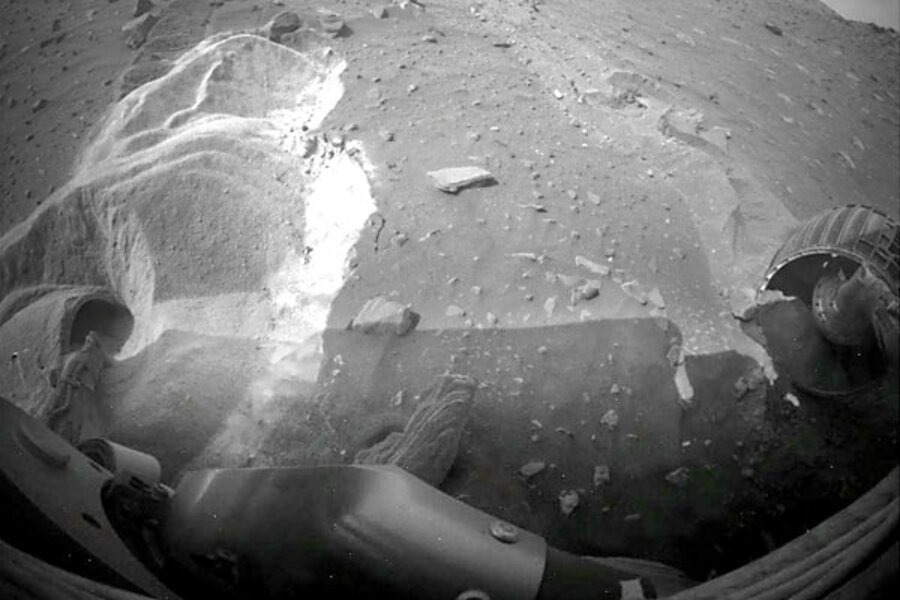NASA Mars rover Spirit to rove no more
Loading...
NASA's robotic rover Spirit is entering the most dangerous phase of its six-year career on Mars.
With one wheel stuck in the Martian soil and two more out of commission completely, the golf-cart-sized explorer will have to get through a frigid Martian winter.
If it survives, Spirit will become a stationary platform for unique experiments on Mars. If it doesn’t, it will become another historical marker on a planet that has captured the human imagination for millenniums.
"Spirit has encountered a golfer's worst nightmare – the sand trap that, no matter how many strokes you take, you can't get out of it," says Doug McCuistion, who heads NASA's Mars Exploration Program.
The rover – sporting a profile that combines a mechanical horse fly with an ostrich's neck – was traveling across the crater's salt-crusted surface when one wheel broke through and got suck in the soil underneath. It's been stuck there for 10 months. Rover drivers have tried various strategies to free Spirit, all to no avail.
Yet that may be a boon to science if the rover survives the next several months.
Researchers have an understandable desire to keep mobile rovers moving, says Steven Squyres, the mission's lead scientist. But as a research platform in a fixed location, Spirit may be able to answer critical questions about the nature of the planet's core, the impact of the winds on the landscape, and on the nature of the rover's "sand trap" itself.
"Spirit didn't get stuck here by coincidence," Dr. Squyres told reporters at a NASA briefing in Washington Tuesday afternoon. "Spirit got stuck here because this is a really strange set of soil that we have roamed into."
The soil is heavily laced with sulfate salts, Squyres explains, suggesting material laid down by ancient, Yellowstone-like fumaroles belching acidic steam. Moreover, it appears to be layered, suggesting successive eruptions and perhaps the action of thin films of surface water moving salts around.
Can Spirit survive a Martian winter?
Now, during late fall in Mars' Southern Hemisphere, rover drivers are trying to reorient Spirit so its solar panels can gather as much sun as possible during the long Martian winter, in order to keep the batteries from failing.
Spirit can operate at around -40 degrees Celsius temperatures but not at temperatures -55 or colder, says John Callas, project manager for Spirit and its twin, Opportunity, at NASA's Jet Propulsion Laboratory in Pasadena, Calif. While the expected winter temperature falls neatly in between these temperatures – around -45 degrees Celsius (-49 Fahrenheit) – Mr. Callas says estimates of temperature tolerance are for a brand-new rover, not one with six years and 4.8 harsh Martian miles on its TripTik.
Throughout the winter, Spirit will be hibernating. The only electronics running will be its master clock. On cue from that clock, Spirit will briefly check the power levels in its batteries each day. If the batteries hold a sufficient charge, the rover will try to communicate with Earth. If the batteries are too low, Spirit will go back to sleep. It's possible that controllers on Earth may hear nothing from Spirit for months, Callas says.
Insights on the planet’s core
Despite the challenges, the research team has enough confidence in the plucky rover to have mapped out a science program that goes beyond studying the soils in Spirit's vicinity.
When or if Spirit awakens, scientists can use its radio signals to measure the wobble in Mars' orbit, Squyres explains. If the planet has a solid core, it will display one type of wobble, he says. If it has a liquid core, it will wobble in an “ever-so-slightly different way," he continues.
It's an experiment that has never been done before on the red planet, and would be a major achievement for Spirit, he says.
In addition, the rover will be able to track changes to the landscape made by winds "fundamental to shaping the Martian surface," he says.
Opportunity marches on
Meanwhile, Spirit's twin, Opportunity, continues its mobile exploration of Meridiani Planum, a broad plain closer to the Martian equator than Gusev Crater where Spirit is stuck. This enables Opportunity to endure a Martian winter with much brighter power prospects than Spirit faces.
In six years, Opportunity has travel nearly 12 miles across the plain. It's currently closing in on Concepcion Crater, a 33-foot wide ding in the Martian surface thought to be only 1,000 years old. It's the youngest crater rovers have yet visited. At this point, Opportunity is about a football field's length away.
---
Follow us on Twitter.





